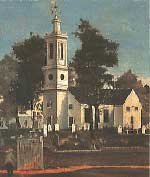





Survey of
Historic Sites and Buildings
 |
ST. JOHN'S EPISCOPAL CHURCH |
|
| ||
Ownership and Administration (1961). The church and southern half of cemetery are owned by the congregation of St. John's Episcopal Church. The northern half of the cemetery is owned by the City of Richmond.
Significance. In St. John's Church on March 23, 1775, Patrick Henry, spellbinding orator of the Revolution, achieved immortal fame with his "Liberty or Death" speech, which sounded a clarion call for his fellow Virginians. Henry had been in the public eye for a dozen years. His brilliant defense of colonial self-government in the "Parson's Cause" of 1763 attracted widespread attention. Two years later his "Virginia Resolutions," inspired by the Stamp Act, stirred the Colonies and propelled Henry to leadership of the radical party in Virginia. None who heard the speech was likely to forget the concluding words: "Caesar had his Brutus—Charles the first, his Cromwell—and George the third . . . may profit by their example." Henry continued to hold the forefront during the decade of increasing colonial agitation that ended in war. As a delegate to the First Continental Congress in September 1774, he strongly supported the radical measures, and his conduct gave evidence of strong nationalist leanings.
 |
Virginia's Royal Governor, Lord Dunmore, called a meeting of the general assembly for late in November 1774 but prorogued it when he learned of the participation of the Virginia leaders in "The Association" to boycott British goods. Members of the prorogued assembly arranged to meet in Richmond on March 20, 1775. For the meeting place, they chose the largest building in the community, the "New Church" or the "Church on Richmond Hill," as it was variously called. When the convention assembled, most of the leaders of Virginia politics were present. Among the approximately 120 members were George Washington, Thomas Jefferson, Patrick Henry, George Wythe, Benjamin Harrison, Edmund Pendleton, Robert Carter Nicholas, Carter Braxton, George Mason, Richard Henry Lee, Thomas Nelson, Jr., Richard Bland, and Andrew Lewis.
The tone of the convention was conciliatory at first, but Henry soon offered a series of resolutions to put the colony into a state of defense. The resolutions were defended by Lee, Washington, and Jefferson, but the conservative members—Pendleton, Bland, Nicholas, and Harrison—attacked them as rash and provocative. On March 23 Henry rose to defend the resolutions in a short speech, which closed with the following stirring words, as reported later:
There is no retreat but in submission and slavery! Our chains are forged. Their clanking may be heard on the plains of Boston! The war is inevitable—and let it come!! I repeat it, sir, let it come!!! It is vain, sir, to extenuate the matter. Gentlemen may cry, peace, peace, but there is no peace. The war is actually begun! The next gale that sweeps from the north will bring to our ears the clash of resounding arms! Our brethren are already in the field! Why stand we here idle? What is it that gentlemen wish? What would they have? Is life so dear or peace so sweet, as to be purchased at the price of chains and slavery? Forbid it, Almighty God—I know not what course others may take; but as for me, give me liberty, or give me death.
The speech swept the convention to Henry's viewpoint, and his resolutions passed. True to his prophecy, news of the outbreak of fighting at Lexington and Concord came within a short time, and the Colonies were at war.
The church in which Henry made his speech was built in 1740-41, on land donated by Col. William Byrd, and remained the only church in Richmond until 1814. Originally constructed as a simple rectangular building, 25 feet wide and 40 long, with the long axis running east and west, the church was enlarged in December 1772. At this time an addition was built on the north side and the interior rearranged so that the addition became the nave. At the same time, also, a belfry was constructed over the west end of the original church. This was the church as it existed at the time of Patrick Henry's famous speech.
Present Appearance (1961). St. John's Church has been altered several times since 1772. In 1830 the nave was enlarged and the interior of the church rearranged. In the next few years, the original belfry was taken down and replaced by a tower and bell at the north end. A chancel and vestry room were added to the south end in 1880, giving it the cross shape it now has. A hurricane blew down the spire in 1896. The replacement was similar to the original spire of the time of Henry's speech. In 1799 the City of Richmond added two lots to the church property, and the church cemetery became a public burying ground. It was the only public cemetery in Richmond until 1826. Among the graves are those of George Wythe and Elizabeth Arnold Poe mother of Edgar Allan Poe.
The church is attractively maintained and is one of the most noted of Richmond's historic shrines. In spite of inadequate parking space, visitation averages about 50,000 people a year. The area surrounding St. John's Church has been designated a historic zone, and plans for its restoration are being carried out by the Historic Richmond Foundation. In the few square blocks of the zone are about 70 ante bellum homes a number of which have already been restored. [76]
 |
 |
http://www.cr.nps.gov/history/online_books/colonials-patriots/sitec57.htm
Last Updated: 09-Jan-2005